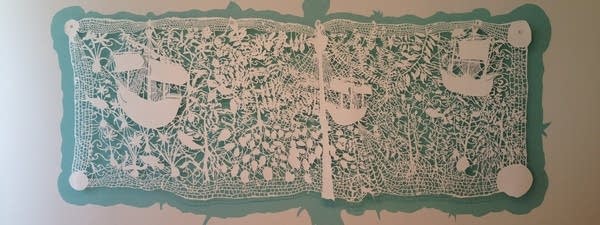Sonja Peterson’s ‘Seemingly Useless Parts’ traces the impact of Wall Street


There is a subtle fierceness to Sonja Peterson's work.
At first glance her finely detailed paper, turned to lace with thousands of cuts, is both whimsical and pretty. But take a closer look, and the images transform from 'Seussical' to downright unsettling. Fishing nets and pipelines tangle with nature, creating a dark morass.

Her inspiration is the modern economy, from collateralized debt obligations to mortgage-backed securities, and the real, physical impact the economy has on our planet.
"Stock and trade on Wall Street is such an abstract idea," said Peterson. "But so often in the effort to make a dollar, it’s the environment that takes the hit."
Create a More Connected Minnesota
MPR News is your trusted resource for the news you need. With your support, MPR News brings accessible, courageous journalism and authentic conversation to everyone - free of paywalls and barriers. Your gift makes a difference.
To bring images of trade to life, Peterson went back in time, tracing the history of commerce to the mining of silver and the trade of spices. Some of her works on paper depict cocoa, vanilla, ginger, and other traded goods.
As she began exploring the early days of trade, she also saw how it reconnected continents after their long drift apart... with unforeseen consequences.

"There's intentional trade - commerce - and then there's the unintentional – stow-away animals, diseases," explained Peterson. "There are goats that took over islands and decimated their native wildlife. Whole new ecosystems have developed as a result of that, effectively shifting the balance of nature."
That's where the title of her latest show "Seemingly Useless Parts" comes in. As trade focused on certain goods and commodities, it ignored or trampled others, oblivious to the environmental consequences.
So, is it possible to rebalance the environmental books?
"No," sighs Peterson. "There is no balancing at this point. We attempt to create balance, we have to try, and I’m trying to push an awareness of our role in this. Whether we like it or not, we’re all at this point managers of nature, by our daily choices."
In Peterson's piece "Intersections," paper landscapes and cityscapes are joined together by melted beeswax.
"It made me think of the bee colonies and their recent threat of collapse," reflected Peterson. "The bee colonies at one time were perhaps considered a 'seemingly useless part' until we realized the extent of what they pollinated. In fact they hold much of our food sources together. Without them many plants would not produce their fruit. They are an integral adhesive, binding us to nature in order for us to flourish."

While the bank bailouts of 2008 may seem like ancient history to some, for Peterson it's a constant source of inspiration as she continues to examine the consequences of an increasingly complex economy.
"I can’t stop looking at it," she says. "I don’t think there have been significant changes in reining in the intentional complexity our trade system – the people who are in charge of regulating are bankers themselves. So I just keep looking at it from different perspectives, and at different points in time."
Peterson's "Seemingly Useless Parts" runs through November 10 at Burnet Gallery in downtown Minneapolis.